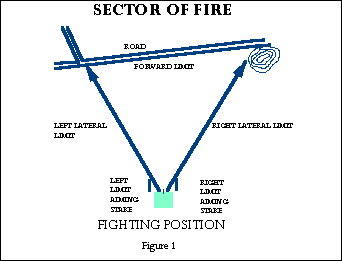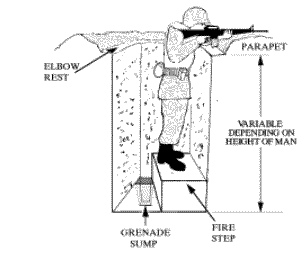|
Medical Education Division |
Operational Medicine 2001
Field Medical Service School
Student Handbook

DEFENSIVE
COMBAT
|
|
“The
whole art of war consists of well-reasoned and extremely circumspect defensive,
followed by rapid and audacious attack.”
Napoleon
|
Important Notice! |
TERMINAL
LEARNING OBJECTIVES
1.
Given a
combat environment (day and night), and individual combat equipment, demonstrate
defensive operations and rear area security per the reference.
(FMST.02.04)
ENABLING
LEARNING OBJECTIVES
1.
Without
the aid of reference material and given a list of terms associated with
defensive combat, select the purpose of defensive combat, per the student
handout. (FMST.02.04a)
2.
Without
the aid of reference material and given a list of terms associated with
defensive combat, select three (3) types of fighting positions in the defense,
per the student handout. (FMST.02.04b)
3.
Without
the aid of reference material and given a list of terms associated with
defensive combat, select two (2) fundamentals of defensive combat, per the
student handout. (FMST.02.04c)
4.
Without
the aid of reference material and given a list of terms associated with
defensive combat, select the purpose of individual fighting positions, per the
student handout. (FMST.02.04d)
OUTLINE
A.
PURPOSE. The purpose of defensive action is to retain or control
terrain, gain time, develop more favorable conditions for offensive action, or
to economize forces to allow the concentration of forces elsewhere.
B.
MISSION. The mission of the squad in the defense is, with the support
of other arms, to stop the enemy by fire as he approaches the battle position,
and to repel his assault by close combat if he reaches the battle position.
For the rifle squad, this mission can be divided into three parts:
-
To destroy the enemy by fire once he comes into small arms range of the squad’s fighting position. The enemy is destroyed as far forward of the squad’s fighting position as possible. The closer the enemy gets, the more friendly casualties he will inflict.
-
To repel the enemy assault by continuing to deliver fire as part of the unit’s final protective fires and by close combat
-
If the enemy succeeds in penetrating the platoon battle position, the squad holds its fighting position, delivering fire on the intruding enemy and participating in counterattacks to destroy the enemy and restore the battle position.
C.
DEFINITIONS
-
Sector of Fire. A sector of fire is an area which of responsibility covered by an individual, a fire unit (squad or fire team), or a crew-served weapon. It is a pie-shaped area enclosed by two lateral limits and a forward limit. See figure 1.
a.
Lateral
Limit. These are readily identifiable terrain features that are
selected to indicate the line of sight long each side of the sector.
These terrain features should be located near the forward limit of the
sector so that all fire team members assigned to cover this sector use the same
limiting features. Two stakes, placed near the position of the weapon, are used
to indicate the lateral limits during periods of restricted visibility.
These should be emplaced prior to darkness.

b.
Forward
Limit. The forward limit is established at the range at which the
weapons may open fire. For rifles
and automatic rifles, this may extend up to their maximum effective ranges.
When possible, a terrain feature is selected to locate the forward limit.
As the attacker passes this limit, he is brought under fire. This allows the squad leader a positive means to control the
commencement of small arms fire.
-
Fighting Position. A fighting position is a location on the ground from which fire is delivered by an individual, a fire unit, or a crew-served weapon. See figure 2.
a.
Primary
Fighting Positions. The primary fighting position is the best available position
from which the assigned sector of fire can be covered. Individuals, fire teams, squads, and crew-served weapons are
assigned primary positions.
b.
Alternate
Fighting Positions.
An alternate position is located so that a unit can continue to
accomplish its original mission when the primary position becomes untenable or
unsuited for carrying out that mission.
c.
Supplementary
Fighting Positions.
Supplementary fighting positions are secondary positions that do not
cover the same sector of fire as the primary position.
Supplementary positions provide security by protecting against attacks
from directions other than those covered by primary positions.

-
Battle Positions. A position on which the main effort of defense is concentrated. A battle position is made up of a series of sectors of fire that support one another.
-
Principle Direction of Fire. A principle direction of fire (PDF) is a specific direction within the sector of fire, given to a flat trajectory weapon, and designated as its primary fire mission. Within a rifle squad, a PDF is assigned to automatic weapons. Automatic weapons can not have more that one PDF. Units are not assigned a PDF. Rifleman may be assigned a PDF in periods of reduced visibility.
D.
FUNDAMENTALS
OF DEFENSE. The following fundamentals are applicable to all tactical
levels (fire team, squad, platoon, company, etc.).
Application of these fundamentals by all units increases the chances for
a successful defense.
-
Preparation. The defender will arrive at the battlefield before the attacker. Upon his arrival at the position he is to defend, the squad leader must ascertain from the platoon commander how much time is available to prepare his defensive position. If time is available to prepare the position the squad leader must use it wisely; if not, he prepares a hasty defense.
-
Concentration. Forces must be concentrated to prepare for attacks at the most likely spots.
-
Flexibility. At the squad level, flexibility is achieved through the continuous development of various courses of action to meet the enemy threat. The defender must continuously ask himself, “What do I do if the enemy does this…?”.
-
Maximum use of Offensive Action. The squad will be tasked by the platoon commander to conduct various types of patrols to maintain contact with the enemy. The defender must instill an offensive state of mind and aggressive spirit. Collecting creature comforts must not be allowed as it can affect the physical and mental ability of the squad to move out quickly and aggressively.
-
Proper use of Terrain. Take maximum advantage of the military aspects of terrain. Use the acronym OCOKA-W:
a.
Observation
and fields of fire
b.
Cover and
Concealment
c.
Obstacles
d.
Key
Terrain
e.
Avenues
of Approach
f.
Weather
-
Mutual Support. Units and supporting weapons are located and employed so that they can assist one another. An isolated unit is easily destroyed by the enemy. Positions should be located so that when attacking one, the enemy comes under fire from at least one other position.
-
Defense in Depth. If the attacker penetrates the frontline squads, those squads may move to supplementary positions to continue to engage the enemy, or they may be part of a counterattack to drive the enemy back.
-
Surprise. The defender must employ every means available to mislead the enemy as to the true locations of his positions, his strengths, and the disposition of his organic weapons as well as the crew-served weapons located in his sector.
-
Knowledge of the enemy. Since the defense reacts largely to what the attacker does, the defender should learn about the enemy’s capabilities. Having an idea as to what the enemy can do, what weapons he will employ, and what his strength is, will help the unit leader organize his defense.
E.
INDIVIDUAL FIGHTING POSITIONS.
Marines and corpsman must construct fighting positions that protect them
and allow them to fire in their assigned sectors.
When constructed properly, fighting holes provide cover through sturdy
construction, and concealment through proper positioning and proper camouflage.
-
Fighting holes. Fighting holes provide excellent protection against small arms fire, shell fragments, aircraft strafing or bombing, the effects of nuclear detonations, and the crushing actions of tanks.
a.
Dimensions. It is as small as practicable, exposing a minimum target to
fire, wide enough to accommodate the shoulders of a man sitting on the fire
step, long enough to permit the use of an entrenching tool, and at least 4 feet
deep to the fire step.
b.
Water
Sump. A water sump, below the fire step, is dug at one side of the
fighting hole to collect water and to provide space for the individual’s feet
while he is seated on the firing step.
c.
Grenade
Sump. A circular grenade sump is dug into the wall of the fighting
hole facing the enemy, at the lower part of the water sump.
If a grenade is thrown into the fighting hole, the individual is to kick
the grenade into the grenade sump while he dives out of the hole.
d.
Parapet. A mound of soil is placed in front of the fighting hole for
added protection and camouflage.
e. Camouflage. Concealment from the enemy ground and aerial observation is very important to every fighting hole. Camouflage measures are begun from the moment the position is occupied and are continued as long as the individual is there.

Figure
3. Two-Man Fighting Hole
REFERENCE:
Marine
Rifle Squad, FMFM 6-5
Field Medical Service School
Camp Pendleton, California
Approved for public release; Distribution is unlimited.
The listing of any non-Federal product in this CD is not an endorsement of the product itself, but simply an acknowledgement of the source.
Operational Medicine 2001
Health Care in Military Settings
Home · Military Medicine · Sick Call · Basic Exams · Medical Procedures · Lab and X-ray · The Pharmacy · The Library · Equipment · Patient Transport · Medical Force Protection · Operational Safety · Operational Settings · Special Operations · Humanitarian Missions · Instructions/Orders · Other Agencies · Video Gallery · Phone Consultation · Forms · Web Links · Acknowledgements · Help · Feedback
Bureau of Medicine and
Surgery |
Operational
Medicine |
United States Special Operations Command 7701 Tampa Point Blvd. MacDill AFB, Florida 33621-5323 |
*This web version is provided by The Brookside Associates Medical Education Division. It contains original contents from the official US Navy NAVMED P-5139, but has been reformatted for web access and includes advertising and links that were not present in the original version. This web version has not been approved by the Department of the Navy or the Department of Defense. The presence of any advertising on these pages does not constitute an endorsement of that product or service by either the US Department of Defense or the Brookside Associates. The Brookside Associates is a private organization, not affiliated with the United States Department of Defense.

